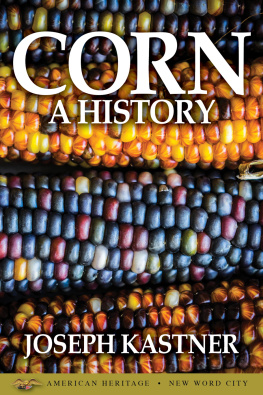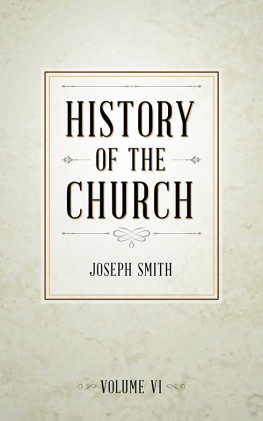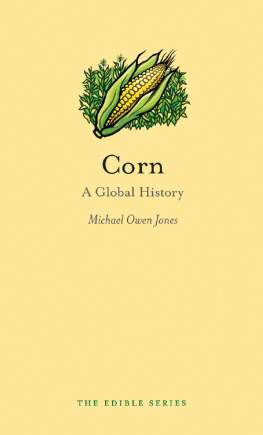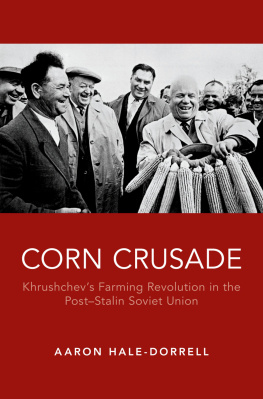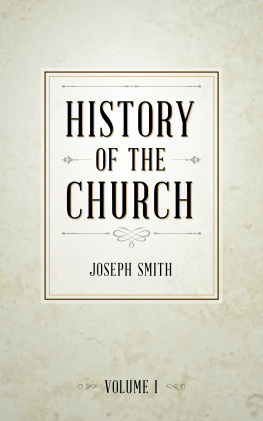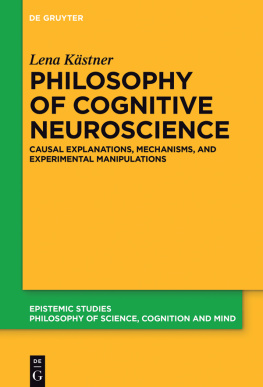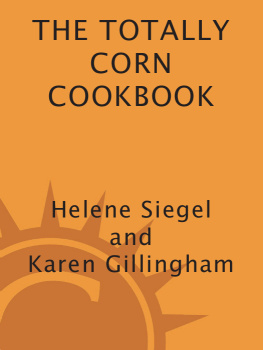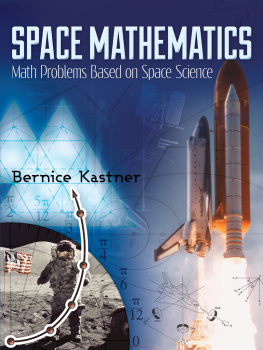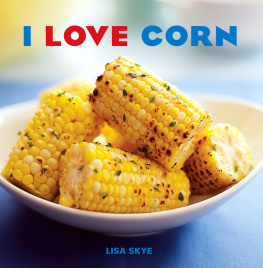Joseph Kastner - Corn: A History
Here you can read online Joseph Kastner - Corn: A History full text of the book (entire story) in english for free. Download pdf and epub, get meaning, cover and reviews about this ebook. year: 2017, publisher: New Word City, Inc., genre: Detective and thriller. Description of the work, (preface) as well as reviews are available. Best literature library LitArk.com created for fans of good reading and offers a wide selection of genres:
Romance novel
Science fiction
Adventure
Detective
Science
History
Home and family
Prose
Art
Politics
Computer
Non-fiction
Religion
Business
Children
Humor
Choose a favorite category and find really read worthwhile books. Enjoy immersion in the world of imagination, feel the emotions of the characters or learn something new for yourself, make an fascinating discovery.
- Book:Corn: A History
- Author:
- Publisher:New Word City, Inc.
- Genre:
- Year:2017
- Rating:4 / 5
- Favourites:Add to favourites
- Your mark:
- 80
- 1
- 2
- 3
- 4
- 5
Corn: A History: summary, description and annotation
We offer to read an annotation, description, summary or preface (depends on what the author of the book "Corn: A History" wrote himself). If you haven't found the necessary information about the book — write in the comments, we will try to find it.
Its our most important, profitable, and adaptable crop - the true American staple. But where did it come from? Here, in this essay by National-Book-Award nominee Joseph Kastner, is the surprising and little-told history of corn.
Corn: A History — read online for free the complete book (whole text) full work
Below is the text of the book, divided by pages. System saving the place of the last page read, allows you to conveniently read the book "Corn: A History" online for free, without having to search again every time where you left off. Put a bookmark, and you can go to the page where you finished reading at any time.
Font size:
Interval:
Bookmark:
In 1748, an inquisitive Swede named Peter Kalm, a protg of the great botanist Linnaeus, came to America to find plants that could be useful in his country. He asked Benjamin Franklin about hardy trees and was told that English walnuts did not survive Philadelphias winters. He asked Quaker John Bartram, the most knowledgeable botanist in the colonies, about timber and was told that American oaks were not as tough as European. He asked physician Cadwallader Colden, later to become the lieutenant governor of New York, about medicinal plants, and was informed that the root of skunk cabbage helped cure scurvy.
But the answer to one question eluded Kalm. Everywhere he went he asked about maize, or Indian corn. The Indians baked it into bread (adding huckleberries in season), brewed it into beer (blue corn was best for this), and used it as a poultice. But no one could tell him where corn came from. Some Indians said a blackbird brought it from the west; others said a beautiful maiden shook it out of her hair. These answers, of course, did not satisfy Kalms rationalist mind.
Scientists today can appreciate Kalms frustration. They have been repeating his simple question for more than two centuries and have come up with only half the answer. After much deliberation, they have agreed that corn came from this continent - not from Asia as once thought - and grew originally in Middle America. But that answer addressed only the geographical question. What scientists really want to know is corns ancestry. The search for the answer has sent botanists into fruitless hunts for hypothetical wild grasses and put geneticists through tedious evolutionary exercises in breeding corn backwards . The investigation has pitted three botanical theorists against each other - Paul Christoph Mangelsdorf versus George Beadle versus Paul Weatherwax - and has provoked long seminars deliberating the mystery of maize.
It seems strange that such a familiar plant should have any mystery surrounding it. Everyone knows corn. It is a staple crop not just in Nebraska but in Bulgaria, Nigeria, and Thailand. The highly adaptable plant grows from Canada to Chile, in humid sea-level marshes and rarified Andean plateaus. This amenable plant breeds so readily and crosses its genes so promiscuously that any kind of corn for almost any purpose can be created. Corn is universally useful, fattening hogs and cows while nourishing people with tortillas and polenta, refreshing us with beer and bourbon, and holding together things like wallpaper paste and jelly beans.
In the center of the mystery surrounding corn is a Mexican weed called teosinte . A tall, tasseled plant found in and around cornfields, teosinte looks so much like corn in its early stages that farmers neglect to weed it out, leaving it to pollinate corn and be pollinated by it. Teosinte is so much like corn that everyone agrees the two are related. But in what way? Adherents of geneticist Beadle say teosinte is the ancestor of corn. Those subscribing to agronomist Mangelsdorfs theory argue, instead, that corn is the ancestor of teosinte. Those in the Weatherwax school say that corn and teosinte are cousins.
A hundred and fifty years ago, a primitive kind of corn named pod corn was believed to be the wild progenitor of modern corn. Then, later in the nineteenth century, when the relationship between corn and teosinte was recognized, the teosinte-as-ancestor theory took hold. In 1939, Mangelsdorf of Harvard and R. G. Reeves of Texas went back to the pod corn theory.
After gathering persuasive genetic and botanical evidence to substantiate their belief, Mangelsdorf and Reeves found concrete support in archaeology. The first evidence came in 1948 from the Bat Cave in western New Mexico, where prehistoric Indians lived from about 3000 BCE to CE 1000. Digging methodically in the cave floor through layer after layer of garbage, offal, excrement, and broken pottery, excavators found 776 corncobs. Not one had a single kernel left on it. But over the centuries, 125 kernels had been carelessly dropped and overlooked by beetles and rodents (though back at Harvard, where they were studied, mice got into the cache of ancient kernels and ate several). At the bottom were tiny cobs, 5,000 years old. In the oldest of the remnants, there was no indication of teosinte. In an earlier expedition working caves at Tehuacn near Oaxaca in Mexico, diggers uncovered a 7,000-year-old cob. Based on the evidence, Mangelsdorf concluded that this was wild corn. When drillers in Mexico City found grains of corn-like pollen at soil levels 80,000 years old, Mangelsdorf was convinced his thesis was correct. The ancestor of corn, he said with finality, was corn.
Mangelsdorfs conclusion, however, did not impress other scientists. The Beadlites dismissed the Tehuacn wild corn as an early cultivated variety since humans were known to be farming by then. Declaring the dating of the old pollen to be highly suspect, they offered complex genetic data to prove that only a few minor mutations in teosinte, which was growing at least 7,000 years ago, would give it corn-like qualities. When that happened, they theorized, the Native Americans who collected and ate teosinte seed for food noticed the improved varieties and found a way to grow it for themselves. Gradually teosinte evolved into corn. Isnt it odd, the Beadlites asked the Mangelsdorfians, that ancient strains of wheat, barley, and other grains still grow wild today, but no one has ever found any wild corn? Isnt it just as odd, retorted their opponents, that no one has ever found any traces of teosinte at one of the stages it supposedly passed through while evolving into corn?
The arguments were further complicated by another relative of corn and teosinte: Tripsacum, sometimes called gama grass , which grows throughout the Americas. The late botanist Paul Weatherwax (1888-1976) of Indiana University, studying the resemblances between the plants, deduced that all three descended from the same wild grasses. Though Weatherwaxs theory has less support than the others, it has not been altogether discarded.
The matter could be settled, of course, if someone could find a missing link between teosinte and corn, or some corn everyone agreed was wild. (Modern corn relies on man to survive. It cannot disperse its seed; if an ear fell to the ground, the kernels would sprout into plants so tightly bunched together that they would choke each other out.) In the 1960s, a team of plant hunters mounted a botanical safari in Mexico to gather samples of teosinte and look for evolutionary clues. Despite returning with as many as 75,000 samples, Mangelsdorf reported, the search proved nothing scientifically but did provide everyone with a memorable adventure. Mangelsdorf, who admitted that his lifetime quest could be regarded as a form of monomania, attempted to create strains of wild corn in his test plots. Trying to reverse evolution, he bred corn backwards . He was ultimately unable to reconstruct a wild species, ending up, as he put it, with probably the worlds most unproductive corn.
George Beadle, who won a Nobel Prize for his work in medicine and physiology, actually submitted his own digestive tract as evidence to support his pro-teosinte theory. Citing what he called a friendly disagreement with Professor Mangelsdorf on the edibility of teosinte, he undertook the Scrimshaw test. Following a regime devised specifically for him by Dr. Nevin Scrimshaw, a nutritionist at the Massachusetts Institute of Technology, he set out to eat teosinte as prehistoric man would have: crushed seeds, hulls and all. After four days on this diet, the intrepid Nobel laureate announced that he suffered no unpleasant consequences.
Geologists and paleontologists have vigilantly scoured the earth for evidence of fossil corn. There was a furor some years ago when the Smithsonian Institution acquired a petrified ear of corn that had been unearthed in a curio shop in Cuzco. After some soul searching, the institution decided to analyze it rather than put it on display. When the cob was dissected, it turned out to be an ancient toy, a childs rattle made out of clay to imitate an ear of corn.
Next pageFont size:
Interval:
Bookmark:
Similar books «Corn: A History»
Look at similar books to Corn: A History. We have selected literature similar in name and meaning in the hope of providing readers with more options to find new, interesting, not yet read works.
Discussion, reviews of the book Corn: A History and just readers' own opinions. Leave your comments, write what you think about the work, its meaning or the main characters. Specify what exactly you liked and what you didn't like, and why you think so.

